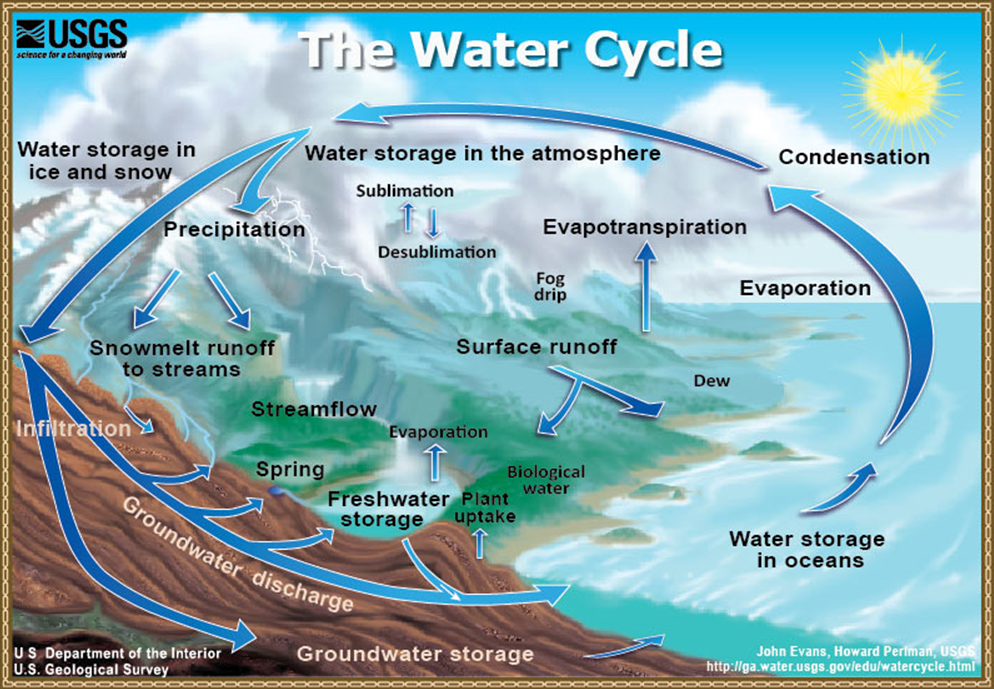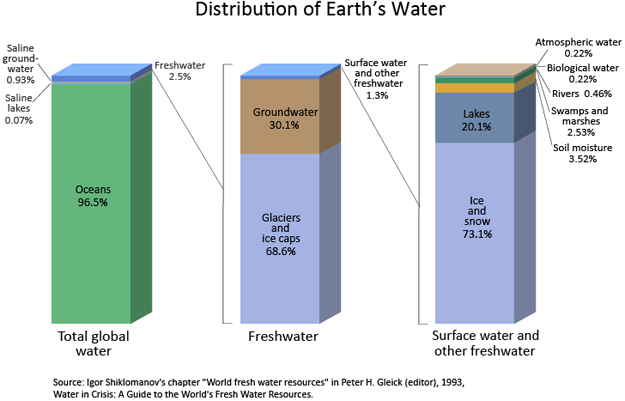8.1: Water Resource Availability
- Page ID
- 15598
\( \newcommand{\vecs}[1]{\overset { \scriptstyle \rightharpoonup} {\mathbf{#1}} } \)
\( \newcommand{\vecd}[1]{\overset{-\!-\!\rightharpoonup}{\vphantom{a}\smash {#1}}} \)
\( \newcommand{\id}{\mathrm{id}}\) \( \newcommand{\Span}{\mathrm{span}}\)
( \newcommand{\kernel}{\mathrm{null}\,}\) \( \newcommand{\range}{\mathrm{range}\,}\)
\( \newcommand{\RealPart}{\mathrm{Re}}\) \( \newcommand{\ImaginaryPart}{\mathrm{Im}}\)
\( \newcommand{\Argument}{\mathrm{Arg}}\) \( \newcommand{\norm}[1]{\| #1 \|}\)
\( \newcommand{\inner}[2]{\langle #1, #2 \rangle}\)
\( \newcommand{\Span}{\mathrm{span}}\)
\( \newcommand{\id}{\mathrm{id}}\)
\( \newcommand{\Span}{\mathrm{span}}\)
\( \newcommand{\kernel}{\mathrm{null}\,}\)
\( \newcommand{\range}{\mathrm{range}\,}\)
\( \newcommand{\RealPart}{\mathrm{Re}}\)
\( \newcommand{\ImaginaryPart}{\mathrm{Im}}\)
\( \newcommand{\Argument}{\mathrm{Arg}}\)
\( \newcommand{\norm}[1]{\| #1 \|}\)
\( \newcommand{\inner}[2]{\langle #1, #2 \rangle}\)
\( \newcommand{\Span}{\mathrm{span}}\) \( \newcommand{\AA}{\unicode[.8,0]{x212B}}\)
\( \newcommand{\vectorA}[1]{\vec{#1}} % arrow\)
\( \newcommand{\vectorAt}[1]{\vec{\text{#1}}} % arrow\)
\( \newcommand{\vectorB}[1]{\overset { \scriptstyle \rightharpoonup} {\mathbf{#1}} } \)
\( \newcommand{\vectorC}[1]{\textbf{#1}} \)
\( \newcommand{\vectorD}[1]{\overrightarrow{#1}} \)
\( \newcommand{\vectorDt}[1]{\overrightarrow{\text{#1}}} \)
\( \newcommand{\vectE}[1]{\overset{-\!-\!\rightharpoonup}{\vphantom{a}\smash{\mathbf {#1}}}} \)
\( \newcommand{\vecs}[1]{\overset { \scriptstyle \rightharpoonup} {\mathbf{#1}} } \)
\( \newcommand{\vecd}[1]{\overset{-\!-\!\rightharpoonup}{\vphantom{a}\smash {#1}}} \)
\(\newcommand{\avec}{\mathbf a}\) \(\newcommand{\bvec}{\mathbf b}\) \(\newcommand{\cvec}{\mathbf c}\) \(\newcommand{\dvec}{\mathbf d}\) \(\newcommand{\dtil}{\widetilde{\mathbf d}}\) \(\newcommand{\evec}{\mathbf e}\) \(\newcommand{\fvec}{\mathbf f}\) \(\newcommand{\nvec}{\mathbf n}\) \(\newcommand{\pvec}{\mathbf p}\) \(\newcommand{\qvec}{\mathbf q}\) \(\newcommand{\svec}{\mathbf s}\) \(\newcommand{\tvec}{\mathbf t}\) \(\newcommand{\uvec}{\mathbf u}\) \(\newcommand{\vvec}{\mathbf v}\) \(\newcommand{\wvec}{\mathbf w}\) \(\newcommand{\xvec}{\mathbf x}\) \(\newcommand{\yvec}{\mathbf y}\) \(\newcommand{\zvec}{\mathbf z}\) \(\newcommand{\rvec}{\mathbf r}\) \(\newcommand{\mvec}{\mathbf m}\) \(\newcommand{\zerovec}{\mathbf 0}\) \(\newcommand{\onevec}{\mathbf 1}\) \(\newcommand{\real}{\mathbb R}\) \(\newcommand{\twovec}[2]{\left[\begin{array}{r}#1 \\ #2 \end{array}\right]}\) \(\newcommand{\ctwovec}[2]{\left[\begin{array}{c}#1 \\ #2 \end{array}\right]}\) \(\newcommand{\threevec}[3]{\left[\begin{array}{r}#1 \\ #2 \\ #3 \end{array}\right]}\) \(\newcommand{\cthreevec}[3]{\left[\begin{array}{c}#1 \\ #2 \\ #3 \end{array}\right]}\) \(\newcommand{\fourvec}[4]{\left[\begin{array}{r}#1 \\ #2 \\ #3 \\ #4 \end{array}\right]}\) \(\newcommand{\cfourvec}[4]{\left[\begin{array}{c}#1 \\ #2 \\ #3 \\ #4 \end{array}\right]}\) \(\newcommand{\fivevec}[5]{\left[\begin{array}{r}#1 \\ #2 \\ #3 \\ #4 \\ #5 \\ \end{array}\right]}\) \(\newcommand{\cfivevec}[5]{\left[\begin{array}{c}#1 \\ #2 \\ #3 \\ #4 \\ #5 \\ \end{array}\right]}\) \(\newcommand{\mattwo}[4]{\left[\begin{array}{rr}#1 \amp #2 \\ #3 \amp #4 \\ \end{array}\right]}\) \(\newcommand{\laspan}[1]{\text{Span}\{#1\}}\) \(\newcommand{\bcal}{\cal B}\) \(\newcommand{\ccal}{\cal C}\) \(\newcommand{\scal}{\cal S}\) \(\newcommand{\wcal}{\cal W}\) \(\newcommand{\ecal}{\cal E}\) \(\newcommand{\coords}[2]{\left\{#1\right\}_{#2}}\) \(\newcommand{\gray}[1]{\color{gray}{#1}}\) \(\newcommand{\lgray}[1]{\color{lightgray}{#1}}\) \(\newcommand{\rank}{\operatorname{rank}}\) \(\newcommand{\row}{\text{Row}}\) \(\newcommand{\col}{\text{Col}}\) \(\renewcommand{\row}{\text{Row}}\) \(\newcommand{\nul}{\text{Nul}}\) \(\newcommand{\var}{\text{Var}}\) \(\newcommand{\corr}{\text{corr}}\) \(\newcommand{\len}[1]{\left|#1\right|}\) \(\newcommand{\bbar}{\overline{\bvec}}\) \(\newcommand{\bhat}{\widehat{\bvec}}\) \(\newcommand{\bperp}{\bvec^\perp}\) \(\newcommand{\xhat}{\widehat{\xvec}}\) \(\newcommand{\vhat}{\widehat{\vvec}}\) \(\newcommand{\uhat}{\widehat{\uvec}}\) \(\newcommand{\what}{\widehat{\wvec}}\) \(\newcommand{\Sighat}{\widehat{\Sigma}}\) \(\newcommand{\lt}{<}\) \(\newcommand{\gt}{>}\) \(\newcommand{\amp}{&}\) \(\definecolor{fillinmathshade}{gray}{0.9}\)Introduction
The information presented here is intended to provide an overview of water resource availability including how water is used to maintain our quality of life, and how it is used for a variety of purposes including energy production, specifically for shale resource development. Water is obviously crucial to life and we rely on it for almost every aspect of our day to day activities, including for drinking, sanitation, industrial uses, irrigation for crops, food production, recreation, and power development. Water also sustains our environment by providing flow to our streams and rivers. The graphic below summarizes how much water is used in Pennsylvania for a variety of these applications.
The combined amount of water used for domestic and public water supply (about 1.57 billion gallons per day) is more than 100 times greater than the amount of water used for hydraulic fracturing (estimated to be 14.8 million gallons per day) on a daily basis in Pennsylvania.
Exercise 1-1
What is the average amount of water used on a daily basis by each person in Pennsylvania assuming a population of 12.8 million people?
- Answer
-
Approximately 123 gallons per day per person.
The average amount of water used by a family of four in the United States if 400 gallons per day or 100 gallons per day per person (WaterSense). Do Pennsylvanians use more or less water than the national average per person?
- Answer
-
More!
This US Geological Survey Publication provides very interesting water use statistics for Year 2010 for the United States(link is external). Please spend some time (15 minutes, or more if you like) reviewing the report to get a sense of tot US water us and for the state you live in.
Exercise 1-2
Find the per capita domestic water use in your state. Is it above, near, or below the national average?
The amount of water contained on earth is finite with about 333 million cubic miles of water, of which only 2.4% is fresh and 97.5 saline; its occurrence is controlled by the hydrologic cycle as shown below.

Source: U.S. Geological Survey
Water covers nearly 71% of the Earth’s surface: 96.5% of the planet's water is found in oceans, 1.7% in groundwater, 1.7% in glaciers and the ice caps, and 0.1% in clouds or precipitation as illustrated below. Furthermore, of all of the water on earth--about 97.5%--is considered to be unusable; that is, not potable for drinking water purposes. Greater than two thirds of the fresh water on the earth is stored in glaciers and ices caps, with groundwater and surface water representing the other third of fresh water resources. The vast majority of fresh water is frozen in glaciers and ice caps (68.6%) and therefore unavailable for use. The available freshwater comes to us mainly as groundwater (comprising 99% of available fresh water) along with some surface water (1% of fresh water), collectively comprising 30.4% of freshwater resources.

Source: Igor Shiklomanov's chapter "World fresh water resources" in Peter H. Gleick (editor), 1993. Water in Crisis: A Guide to the World's Fresh Water Resources
Exercise 1-3
How much available fresh water (i.e. groundwater and surface water) is there on a global basis in gallons? (Hint, there are 5280 feet in a mile and 7.48 gallons in a cubic foot). How much water does that make available for each person on the planet (assuming it is evenly distributed!)?
- Answer
-
333 million cubic miles of total water times 2.5% of fresh water times 30.4% of fresh water equals 2.53 million cubic miles. Converting to cubic feet and then gallons equals 2,780,000,000,000,000,000 (2.78 quintillion gallons….wow that’s a lot!!). Assuming 7.4 billion people live on the planet that means in theory there is 376 million gallons for each of us on the planet, but unfortunately about 10% of the world’s population does not have access to fresh water and 85% percent live in the driest half of the Earth (UN Water).


